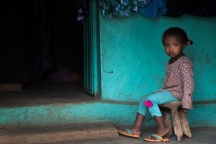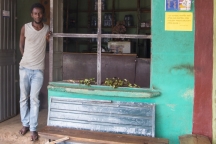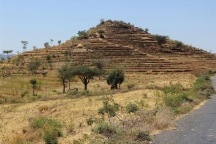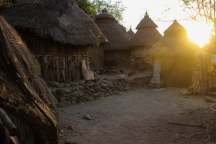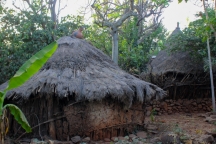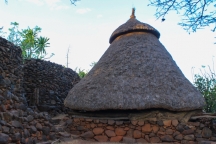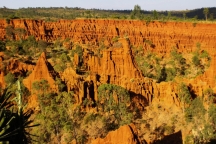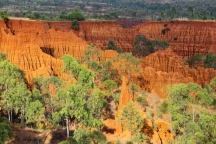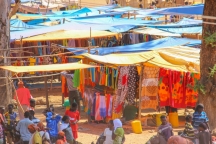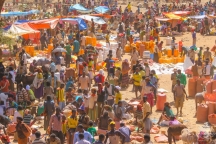Last visited June 2016
Konso lies on the main road from Arba Minch to Jinka and the tribes of the Omo Valley. The town is less than a couple of hours drive from Arba Minch, so most travelers stop for coffee or lunch before going on to Jinka. But there is actually enough to see here for a nice half-day visit at least, and if you can spare the time, it’s worth an overnight stop on the way back from the Omo Valley.
In my two trips to Omo Valley I have always stopped in Konso and overnighted once. There is a great little coffee stand right on the main road to Jinka in the middle of town, and the locally grown and roasted coffee is just terrific, like most Ethiopian coffee. Interestingly, the Konso themselves, do not use the beans of the coffee they grow, but instead dry and ground coffee leaves to mix them with sunflowers seeds and spice for the local version of instant coffee. I’ll have to try it one day.
I stayed overnight at the Konso Edget Hotel, also in town center. The hotel is OK, but nothing I would recommend too enthusiastically. The rooms are small and there is no hot water in the shower (which is common for this part of Ethiopia), but it for how little time you spend here it is not a bad option, especially if you’re on a budget. If you have the money and want to indulge – drive up the main road to Kanta Lodge, a small beautiful property a few kilometers uphill from town. I did not stay here, but from what I’ve seen in read it’s the best hotel in town. I did have few meals at the lodge’s restaurant and they were all quite good.
The main town of Konso is also known as Karat or Karati. It’s a small nondescript town of roughly 5,000 people, and was described by Philip Briggs, the author of a popular travel book on Ethiopia, as “a traffic circle of comically vast dimensions”. And while there is certainly some truth to this humorous description, there is a reason this place is a UNESCO World Heritage Site. it’s just not easily apparent as you go through main street and your first taste of what makes Konso interesting comes when you actually leave town.
As you drive out of town towards Jinka, for about 2 kms past a local market, you will see your first traditional walled Konso town – Dekatu, Although I haven’t visited it, Dekatu has an intriguing-sounding stop called Komaya Heart of Konso Cultural Handicraft Market, which offers tourists craft demonstrations, a small shop and a café with some views of the area. I definitely want to try and stop here on my next trip. But if views are what you are after, there are plenty on the road to Jinka. The area is one of basalt hills and the Konso make the most of this landscape for agriculture through extensive rock terracing, making for a dramatic landscape.
But other than the landscape, it is the traditional fortified villages built on hilltops and surrounded by dry stone walls as high as 2 meters that are the attraction here. To visit the villages you need to purchase a visitors permit for each person and in your group, hire a local guide and get a permit for your vehicle. All of these are inexpensive and I found the guide well worth it and you can do this at the Tourist office in the center of Konso town.
Konso villages are divided into smaller communities, centered around a communal house called mora. Moras are tall buildings with an open ground floor and a high angled roof. This is a place where villagers make important decisions, as well as just hang out. All unmarried young men in the village spend the night in the mora house and even married men spend some time there every night.
Each family owns several houses on a common plot, surrounded by a stone barrier with one low gate, fashioned so that only one person can come through at a time. Like the communal living in the moras, and the placement villages on the top of hills, surrounded by high walls, this is all done for defensive purposes, but now that the area is peaceful, these 400 year traditions are still kept alive. And while the young men in the mora may not need to get up in the middle of the night to defend their village, they still act as a first response team in the event of a fire or natural disaster.
Another interesting Konso tradition is the Kata generation-set, the practice of initiating young men age eight to twenty-five or every 18 into adulthood at the same time, unlike say the Hamer or Bena, where the bull jumping initiation ceremony is an individual affair. The highlight of the ceremony is the erection of a generation pole called Olahita in the main square of the village. So you can tell the approximate age of a Konso village by counting the number of poles in its square and multiplying by 18.
Finally, I have read a bit about the waga sculptures – carved wooden markers usually erected on the graves of prominent Konso soldiers and leaders, but haven’t seen any in the village I have visited. I believe they have all been collected at the recently opened Konso Cultural Center before they were damaged and sold to foreigners. I haven’t visited it, but hope to do this on my next trip.
Your local guide might also want to take you to a place called “New York”, a dry gorge filled with sand pinnacles sculpted by the occasional flows of water. A beautiful site and definitely worth the short trip.
Finally, while it’s not part of the Konso landscape, the town is close to one of the largest and most colorful markets I have seen in Africa. It was a few kilometers outside of town towards Arba Minch. It’s located near a river, so on market days you see all aspects of local life in living color – from buying cattle to doing laundry in the nearby river. We saw this on our last day in Ethiopia on the way back to Arba Minch to catch a flight to Addis and then home. It was a great way to cap off a trip to this beautiful country.


